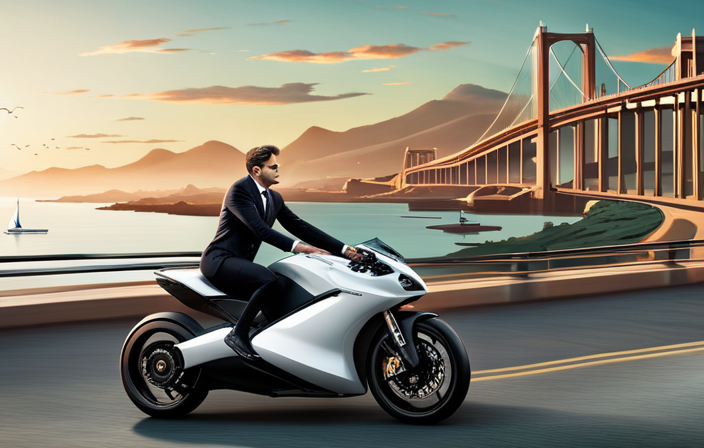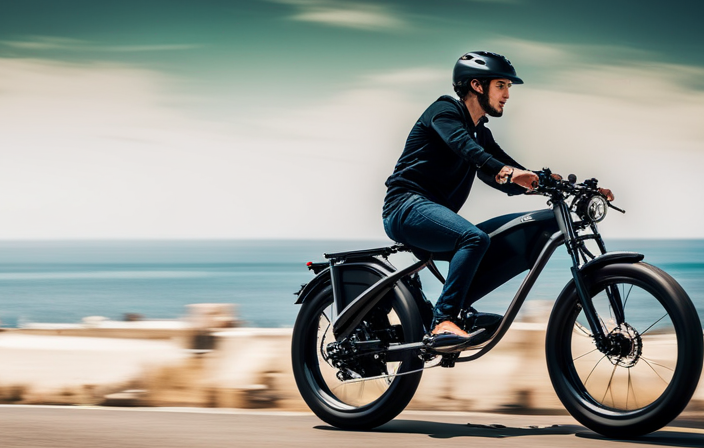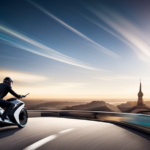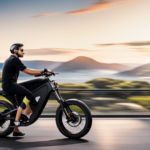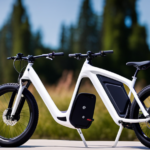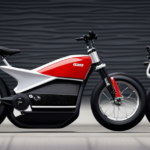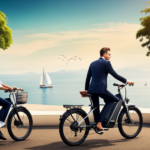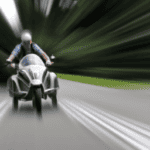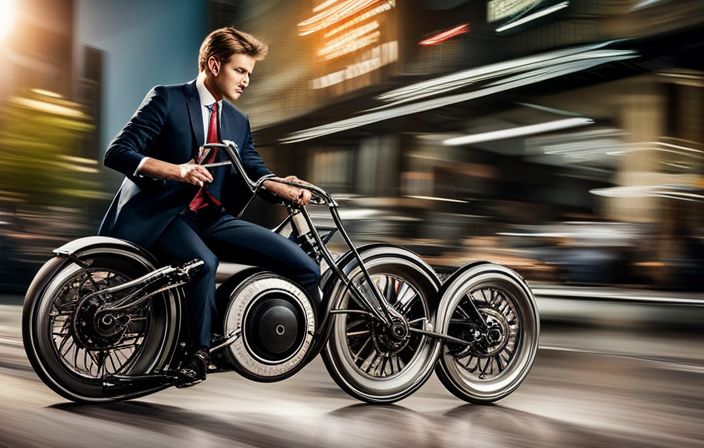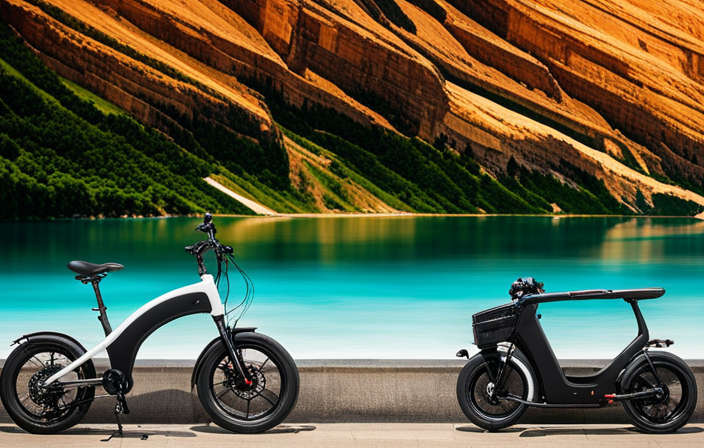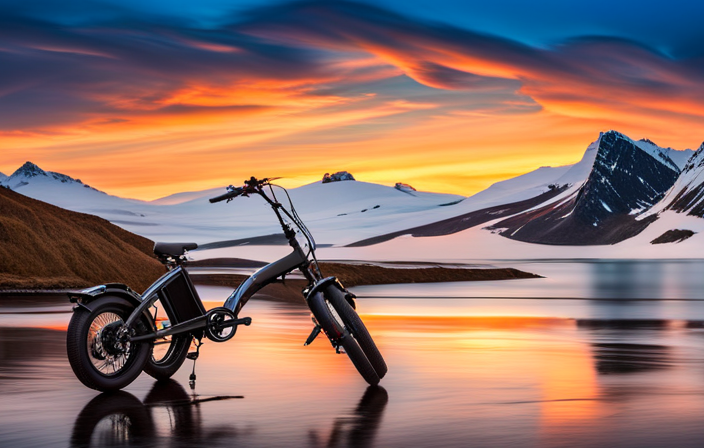Picture this: you’re cruising down the street on your electric bike, wind in your hair, and a smile on your face. But just how fast can your trusty two-wheeled companion take you?
In this article, we’re diving into the nitty-gritty details of electric bike speed. From the different types of motors to the power output limitations, battery capacity, and even legal speed limits, we’ll leave no stone unturned.
So buckle up, fellow riders, as we explore the world of electric bike velocity.
Key Takeaways
- Suspension upgrade and wind resistance reduction can enhance stability, control, and the overall riding experience of an electric bike.
- Prioritizing safety and considering potential risks at higher speeds is crucial to minimize the risk of accidents.
- Upgrading the brake system, particularly to hydraulic disc brakes, can significantly improve stopping power and ensure better braking performance at higher speeds.
- Proper maintenance, including maintaining correct tire pressure, keeping the drivetrain clean and lubricated, and regularly inspecting and maintaining the bike, is essential for maximizing speed, performance, and efficiency of an electric bike.
Types of Electric Bike Motors
The speed of an electric bike can vary depending on the type of motor it has. There are two main types of motors commonly used in electric bikes: brushless and brushed motors. Brushless motors are more efficient and require less maintenance compared to brushed motors. They use electronic commutation instead of physical brushes, resulting in less friction and heat generation. On the other hand, brushed motors are simpler in design and generally less expensive.
Another factor that affects the speed of an electric bike is whether it has a direct drive or geared motor. Direct drive motors provide a smooth and quiet ride, but they tend to have lower torque and top speed. Geared motors, on the other hand, offer higher torque and top speed but may produce more noise.
In conclusion, the speed of an electric bike can be influenced by the type of motor it has, whether it is brushless or brushed, and whether it is direct drive or geared.
Power Output and Speed Limitations
Speed limitations of electric bikes depend on the power output. The power output of an electric bike motor is typically measured in watts. The higher the power output, the faster the bike can go. However, the speed of an electric bike is also influenced by other factors such as battery capacity and weight. A higher battery capacity allows for longer rides, but it doesn’t necessarily mean a higher top speed. On the other hand, a heavier electric bike may have a lower top speed due to the added weight. To illustrate the relationship between power output, battery capacity, and weight on speed, consider the following table:
| Power Output (Watts) | Battery Capacity (Ah) | Weight (lbs) | Maximum Speed (mph) |
|---|---|---|---|
| 250 | 10 | 40 | 20 |
| 500 | 15 | 45 | 25 |
| 750 | 20 | 50 | 30 |
| 1000 | 25 | 55 | 35 |
As you can see from the table, a higher power output, larger battery capacity, and lighter weight generally result in a higher maximum speed for an electric bike.
Battery Capacity and Range
When considering battery capacity and range, you’ll want to take into account factors such as power output and weight to determine the maximum distance you can travel on your electric bike. Battery efficiency plays a crucial role in determining how far your electric bike can go on a single charge. A higher battery efficiency means that your bike can convert more of its stored energy into actual power, allowing you to travel longer distances.
Charging time is another important factor to consider. A faster charging time means less downtime for your bike and more time on the road.
It’s worth noting that battery capacity and range can vary depending on the specific model of your electric bike and the conditions in which you ride, such as terrain and weather. Therefore, it’s always a good idea to consult the manufacturer’s specifications for accurate information on battery capacity and range.
Weight and Aerodynamics
To optimize your riding experience, consider the weight and aerodynamics of your electric bicycle.
The bike weight plays a crucial role in determining how fast your electric bike can go. Generally, a lighter bike will have a higher top speed due to reduced inertia. So, when choosing an electric bike, look for materials like carbon fiber or aluminum that offer a lightweight yet sturdy frame.
Additionally, the aerodynamics of your bike can significantly impact its speed. Wind resistance is a major factor to consider. Streamlined designs with smooth surfaces and minimal drag can help reduce wind resistance and improve your bike’s speed.
Integrating features like aero handlebars, sleek fairings, and a narrow profile can all contribute to a more efficient and faster electric bike.
Terrain and Riding Conditions
The terrain and riding conditions greatly affect the performance of an e-bike. When it comes to bike maintenance, choosing the right tires is crucial.
Different terrains require different types of tires to ensure optimal performance. For example, if you frequently ride on rough terrains with loose gravel or dirt, you would benefit from using wider tires with aggressive tread patterns for better traction and stability. On the other hand, if you mainly ride on smooth paved roads, narrower tires with low rolling resistance would be more suitable to maximize your speed and efficiency.
It’s also important to consider the riding conditions, such as wet or slippery surfaces, as this can affect the grip of your tires. Regularly checking and maintaining the tire pressure is essential for optimal performance and safety.
Overall, selecting the right tires based on the terrain and riding conditions is crucial for getting the most out of your e-bike.
Pedal Assist vs. Throttle Control
One important factor to consider is the difference between pedal assist and throttle control when it comes to determining how fast your electric bike can be.
Pedal assist refers to a system where the motor provides assistance to your pedaling, making it easier to ride and increasing your speed. The pros of pedal assist include a more natural riding experience and increased range as the motor only engages when you pedal. However, it can be less intuitive to use as the level of assistance may not always match your desired effort.
On the other hand, throttle control allows you to control your bike’s speed with a twist or push of a button, similar to a motorcycle. The pros of throttle control include instant power delivery and ease of use. However, it can drain the battery quickly and may not provide the same level of exercise as pedal assist.
Ultimately, the choice between pedal assist and throttle control depends on your personal preferences and riding style.
Legal Speed Limits for Electric Bikes
If you want to stay within the legal speed limits for your e-bike, you should be aware of the specific regulations in your area. Electric bike speed regulations can vary from place to place, so it’s crucial to understand the rules that apply to you.
Exceeding speed limits can have serious consequences, such as fines, points on your driver’s license, or even the confiscation of your e-bike. It’s important to note that the maximum speed allowed for electric bikes is typically lower than that of traditional bicycles. This is because e-bikes are considered motorized vehicles and are subject to different regulations.
Therefore, it’s crucial to familiarize yourself with the specific speed limits for electric bikes in your area to ensure compliance and avoid any potential penalties.
Upgrading and Modifying Electric Bike Speed
To upgrade and modify the speed of your e-bike, you should first consult local regulations to ensure compliance. Once you have determined the legal limits, you can explore various methods to enhance your electric bike’s speed. Two effective strategies are upgrading the suspension system and reducing wind resistance. By upgrading the suspension, you can improve the bike’s stability and control, allowing for smoother and faster rides. Reducing wind resistance can be achieved by adding aerodynamic features such as fairings or streamlining the bike’s frame. These modifications minimize the drag force experienced by the bike, enabling it to move through the air more efficiently. Keep in mind that while these upgrades can improve your e-bike’s speed, it is crucial to balance performance with safety and always ride within the limits of the law.
| Suspension Upgrade | Wind Resistance Reduction |
|---|---|
| – Enhanced stability and control | – Add aerodynamic features |
| – Smoother and faster rides | – Streamline bike’s frame |
| – Improved handling on rough terrains | – Minimize drag force |
Safety Considerations at Higher Speeds
When riding at higher speeds, it is important to prioritize safety and be aware of the potential risks involved.
One key consideration is high-speed stability. As the speed increases, the balance and stability of the electric bike become crucial. A well-designed frame and suspension system can greatly enhance stability, minimizing the risk of accidents.
Additionally, the braking performance is another critical aspect to address. At higher speeds, the stopping distance increases, requiring more efficient and reliable brakes. Upgrading to high-performance brake systems, such as hydraulic disc brakes, can significantly improve the stopping power and ensure safer rides. It is also essential to regularly inspect and maintain the brakes to ensure optimal performance.
By focusing on high-speed stability and improving the braking performance, riders can enjoy the enhanced speed of their electric bikes while maintaining a safe riding experience.
Tips for Maximizing Electric Bike Speed and Performance
Now that we have discussed the safety considerations when riding at higher speeds on an electric bike, let’s delve into some tips for maximizing its speed and performance.
As an electric bike enthusiast, I have learned that proper maintenance plays a crucial role in achieving optimal speed. One key aspect is ensuring the tires are properly inflated. Maintaining the correct tire pressure is essential for reducing rolling resistance and enhancing overall efficiency. By regularly checking and maintaining the tire pressure, you can ensure a smooth and swift ride.
Additionally, proper electric bike maintenance, such as keeping the drivetrain clean and lubricated, can help minimize friction and maximize power transfer, ultimately boosting your bike’s speed and performance.
So, remember to pay attention to tire pressure and perform regular maintenance to unlock the full potential of your electric bike.
Frequently Asked Questions
Are electric bikes as fast as motorcycles or scooters?
Electric bikes have speed limitations due to their motor power and design. While they can reach impressive speeds, they are not as fast as motorcycles or scooters, which have more powerful engines and are specifically designed for high-speed travel.
Can I ride my electric bike at top speed all the time?
Riding at top speed constantly on my electric bike can have adverse effects on battery life and range. It is recommended to ride at a comfortable pace to maximize the efficiency and longevity of the battery.
How long does it take to charge an electric bike battery?
Charging an electric bike battery depends on the charging efficiency, which varies between models. On average, it takes around 3-6 hours to fully charge. However, frequent fast charging can reduce battery lifespan.
Can I ride my electric bike in the rain?
Yes, you can ride your electric bike in the rain. To maintain it, apply a waterproof coating to the electrical components, protect the battery, use fenders and mudguards, and dry the bike thoroughly after each ride.
Are there any special requirements or licenses needed to ride an electric bike at higher speeds?
To ride an electric bike at higher speeds, special safety precautions and legal regulations may apply. These requirements can vary depending on the jurisdiction, so it is important to research and comply with the specific rules in your area.
Conclusion
In conclusion, the speed of an electric bike is influenced by various factors. These factors include the type of motor, power output, battery capacity, weight, terrain, and legal speed limits. It is tempting to upgrade and modify the speed of an electric bike, but safety should always be a top priority. By following safety guidelines and maximizing performance, riders can experience the thrill of riding at higher speeds. It is important to remember that with great power comes great responsibility. So, let’s ride smart and enjoy the electrifying journey ahead.
